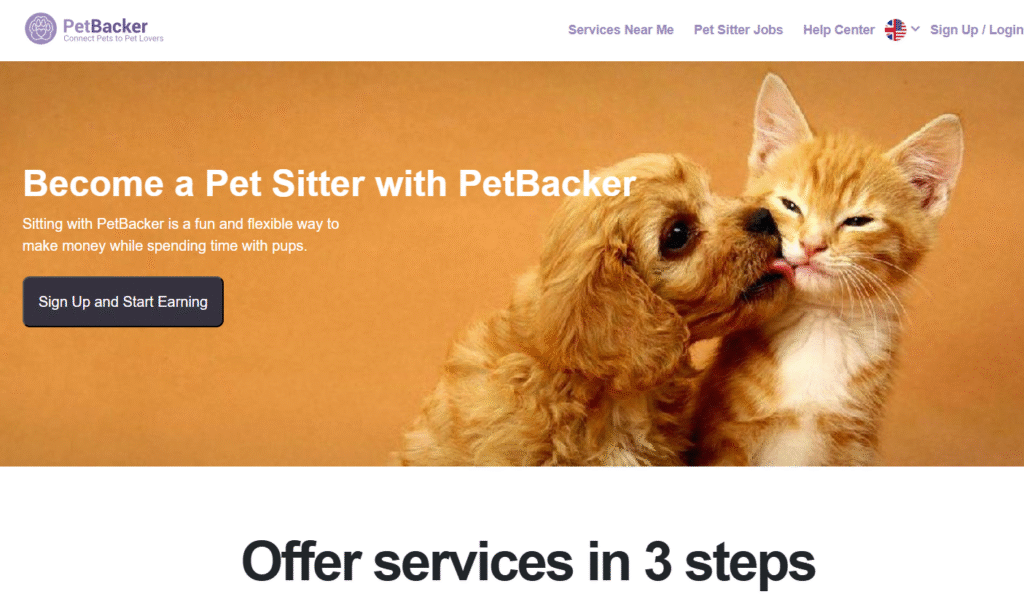How To Make Money Pet Sitting: Your Complete Guide

So you’re scrolling through your phone, seeing yet another adorable pet video, and thinking, “Wait, people actually get paid to hang out with animals?” Yep, they do. And honestly? It’s one of the smartest side hustles you could pick up right now.
Pet sitting has been one of the most enjoyable and rewarding side hustles I’ve ever tried.
It started as a favor for a friend who needed someone to look after her dog for a weekend and before I knew it, word had spread, and I was earning steady income doing something I truly loved.
What surprised me most was how flexible and profitable pet sitting could be once I learned how to turn it into a structured service.
From understanding different pets’ personalities to managing client expectations, every job taught me something new about responsibility, trust, and building lasting relationships with both owners and their furry companions.
Let’s break down exactly how you can turn your love for animals into actual money.
What Is Pet Sitting?
Alright, let’s start with the basics. Pet sitting is when you care for someone’s fur baby (or scaly friend, or feathered companion) while they’re out of town, stuck at work, or just need a helping hand.
Think of yourself as a temporary guardian, someone the pet owner trusts to keep their animal safe, happy, and well-fed.
Now, this isn’t the same as dropping a dog off at a kennel. Pet sitting usually happens in the owner’s home or yours, depending on what works best.
The whole point is to give pets a comfortable, low-stress environment instead of caging them up somewhere unfamiliar.
Here’s what pet sitting can look like in action:
- Feeding and hydration: Making sure Fluffy gets breakfast, dinner, and fresh water throughout the day
- Exercise and playtime: Tossing a ball, going for walks, or just keeping them entertained
- Medication management: Administering pills, shots, or special treatments (if you’re comfortable with that)
- Litter box duty: Yes, someone’s gotta do it
- Cuddles and companionship: Sometimes pets just need someone around so they don’t feel lonely
- Overnight stays: Sleeping over to provide round-the-clock care
Some sitters go the extra mile by watering plants, grabbing the mail, or tidying up the house.
These small add-ons can bump up your rates and make you the go-to person for busy pet parents.
The beauty of pet sitting? You control your schedule. You decide which pets you’re comfortable with, how many clients you take on, and whether you’re doing quick drop-ins or full-on sleepovers.
It’s the kind of gig that Moulds around your life instead of taking it over.
How Much Money Will You Make As A Pet Sitter?

Let’s talk numbers because that’s probably why you’re here, right? You want to know if pet sitting can actually pay your bills or if it’s just pocket change.
Here’s the honest answer: You can make anywhere from $15 to $100+ per gig, depending on what you’re offering and where you live. That’s a pretty wide range, so let me break it down for you.
For quick check-ins (think 30 to 60 minutes), you’re looking at $15 to $30 per visit. These are usually just feeding, playing, and making sure everything’s good before you head out.
If you’re watching pets during the day for several hours, expect $25 to $50 per session.
This might involve more hands-on care, like walking dogs multiple times or hanging out with anxious cats who need extra attention.
Now, overnight stays? That’s where things get interesting. You could charge $50 to $100+ per night, especially if you’re staying at the client’s house and providing full-time care.
Some sitters in high-demand areas or those caring for multiple pets or exotic animals charge even more.
FYI, your rates depend on a few key factors:
- Location: Big cities = bigger paychecks. Pet parents in urban areas tend to pay more because the cost of living is higher and demand is fierce.
- Type of pet: A goldfish is way easier to care for than a parrot or a senior dog with medical needs. Specialised care equals higher fees.
- Number of pets: One cat? Easy. Three dogs and two rabbits? That’s more work, so you should charge accordingly.
- Extra services: Administering meds, grooming, training, or doing household tasks can justify premium pricing.
From a financial perspective, pet sitting falls into a sweet spot. It’s low overhead (you don’t need expensive equipment), scalable (you can start small and grow), and has consistent demand year-round.
The barrier to entry is low, but the income ceiling? That’s entirely up to you.
IMO, if you’re strategic about your pricing and build a solid client base, you could easily pull in $500 to $2,000+ per month part-time.
Go full-time, and some sitters are clearing $3,000 to $5,000 monthly, or even more during peak seasons like summer and holidays.
What To Consider Before You Start Pet Sitting
Before you start booking gigs left and right, let’s pump the brakes for a second. Pet sitting might sound like the easiest money ever, but it’s not all belly rubs and Instagram-worthy moments.
There’s real responsibility involved, and going in unprepared is a fast track to stress (and bad reviews).
Here’s what you need to think about before you officially launch your pet-sitting side hustle.
Do You Really Like Animals?
I know, I know, this seems obvious. But hear me out. Loving animals from a distance is not the same as caring for them when they’re scared, sick, or just being difficult.
Sure, cuddling a puppy on a sunny afternoon sounds dreamy. But are you ready to clean up accidents? Deal with a dog that barks nonstop? Coax a stubborn cat into taking their medication?
If the answer is “maybe” or “ugh, I guess,” this gig might not be for you.
If you’ve never had pets yourself, I’d suggest testing the waters first. Volunteer at a local shelter, offer to watch a friend’s pet for a weekend, or even just spend time around animals to see if you genuinely enjoy it.
This isn’t the time to fake it; pets know when you’re not into them, and so do their owners.
Do You Have The Time?
Here’s a reality check: Pet sitting eats up more time than you think. Even a quick visit involves driving to the client’s place, feeding the pet, playing for a bit, cleaning up, and maybe snapping a few photos to send the owner. Add that up across multiple clients, and your day fills up fast.
And that’s just the scheduled stuff. You’ve also got to factor in:
- Communication: Texting updates, answering questions, coordinating schedules
- Emergencies: Sometimes pets get sick or anxious, and you need to drop everything
- Last-minute requests: “Can you come by tonight instead of tomorrow morning?” happen more than you’d think.
If your schedule is already packed, ask yourself: Can I realistically add this to my plate? Are you available during high-demand times like weekends, evenings, and holidays when most people need sitters?
The more flexible and reliable you are, the more clients will trust you, and trust leads to repeat bookings and referrals.
What Kind Of Pets Are You Comfortable With?
Not all pet sitting jobs involve dogs and cats. You might get requests for birds, rabbits, guinea pigs, reptiles, fish, or even ferrets.
Some animals are chill and low-maintenance. Others? Not so much.
Big, energetic dogs require physical stamina. Shy cats might hide from you the entire time. Exotic pets often have specific care requirements that take research and patience.
And let’s not even get started on aggressive or anxious animals; those need a calm, confident handler.
You don’t have to say yes to everything. In fact, specialising can actually help you earn more. Maybe you become the go-to person for senior dogs.
Or the reptile expert in your neighbourhood. Or the cat whisperer everyone recommends. Niching down makes you memorable and allows you to charge premium rates for your expertise.
Are You Available?
This one’s non-negotiable. If you tell a client you’ll be there at 5 PM, you’d better be there at 5 PM. Pets depend on routine, and owners depend on you.
Forgetting a visit or cancelling last minute isn’t just unprofessional, it’s potentially dangerous for the animal.
Before you accept any booking, make sure you can commit 100%. Life happens, I get it. But you need a backup plan.
Maybe a fellow sitter who can cover for you in emergencies, or a crystal-clear cancellation policy so clients know what to expect.
A digital calendar or scheduling app is your best friend here. Set reminders, sync your bookings, and triple-check your availability before saying yes. Consistency builds trust, and trust builds your reputation.
What About Safety And Liability?
Let’s be real: Things can go wrong. A dog could slip their leash and dart into traffic. A cat might knock over something expensive. Or a pet could get sick or injured on your watch, even if you did everything right.
That’s why covering your bases is crucial. Here’s what I recommend:
- Learn basic pet first aid: There are tons of online courses (some are even free). Knowing how to handle an emergency could literally save a life.
- Create detailed pet profiles: Before your first visit, get all the info, health conditions, routines, emergency contacts, vet details, quirks, triggers, everything.
- Get liability insurance: This protects you if something goes sideways. Some platforms (like Rover) include basic coverage, but if you’re working independently, you’ll want your own policy. It’s not expensive, and it’s worth every penny.
Bottom line? Prepare for the worst, hope for the best, and always have a plan B.
Do You Have Enough Space?
If you’re planning to host pets in your own home (aka in-home boarding), your space needs to be pet-proof and comfortable.
This means:
- No hazards: Hide electrical cords, remove toxic plants, secure sharp objects
- Adequate room: Pets need space to move around, play, and relax
- Secure areas: A fenced yard or a safe indoor zone where they can’t escape or hurt themselves
And here’s the kicker: check with your landlord first. If you’re renting, there might be strict rules about having animals in your apartment, even temporarily.
Getting slapped with a fine or eviction notice because of a pet-sitting gig? Not fun.
If you don’t have the space, that’s fine. You can still do pet sitting at the owner’s home, which is actually what most clients prefer anyway.
Do You Know The Local Rules?
Depending on where you live, you might need a license to operate as a pet sitter, especially if you’re running it as a business or boarding pets at your place.
Some cities also cap how many animals you can watch at once or restrict certain types of pets.
Before you start advertising your services, do some homework:
- Local business regulations: Do you need a business license? Any permits?
- Zoning laws: Is in-home boarding allowed in your area?
- Tax implications: Yes, you’ll need to report your income (more on that later)
I know, bureaucracy is boring. But operating legally protects you from fines and gives clients confidence that you’re legit.
How To Get Started
Alright, you’ve thought it through, you’re ready to commit, and now you want to know: How do I actually get started?
Let’s walk through the steps to launch your pet sitting business the right way.
1. Decide What Kind Of Pet-Sitting Service You Want To Offer

Pet sitting isn’t a one-size-fits-all gig. You’ve got options, and choosing the right ones depends on your lifestyle, space, and comfort level.
A good example is Tina from Austin, who started by watching her neighbor’s cat on weekends.
She enjoyed it and decided to post her services on Rover and Facebook groups.
Within months, she was fully booked and earning about $800 per month part-time.
Eventually, she added dog walking and doubled her income.
Here are the main types of services you can offer:
- Drop-in visits: Quick check-ins (usually 30-60 minutes) to feed, play, and make sure everything’s good
- Dog walking: Taking dogs out for exercise and bathroom breaks (often booked separately)
- Daytime care: Hanging out with pets for several hours while owners are at work
- Overnight stays: Sleeping over at the client’s house to provide round-the-clock care
- In-home boarding: Hosting pets at your own place for extended periods
If you live in a small apartment, in-home boarding might not be feasible. If you have a packed daytime schedule, evening visits or weekend-only gigs might work better.
Start with what you can handle, then expand as you gain experience and confidence.
2. Build Your Experience
Here’s the thing: You don’t need years of professional experience to get started. But you do need credibility. And the fastest way to build that? Start small and close to home.
Lessandro my friendtry it one time. He started by pet-sitting for his sister’s two Labradors while she was on vacation.
After that, her friend hired him for a weekend job, and then another client found him through Facebook.
Within a few months, he had built a small list of regular customers and earned his first 20 five-star reviews. Those reviews helped him attract even more clients and raise his prices.
The more experience you get, the more confident you’ll feel handling different animals and situations from shy cats to excited puppies.
Every happy pet and satisfied client adds to your credibility, making your business grow naturally.
Offer to pet sit for friends, family, neighbours, or coworkers, maybe at a discounted rate or even for free at first. These early gigs help you:
- Get comfortable with the responsibilities
- Learn what works (and what doesn’t)
- Collect testimonials and references
You can also volunteer at an animal shelter or take an online pet care course. These experiences give you talking points for your profile and show potential clients that you’re serious.
Even if you’re just starting, positioning yourself as someone caring, reliable, and eager to learn goes a long way.
3. Set Your Rates
Pricing can feel tricky when you’re new, but it doesn’t have to be. Start by researching what other sitters in your area charge.
Check out platforms like Rover, Wag, or local Facebook groups to get a sense of the going rates.
Your pricing should reflect:
- Your experience level: New sitters often charge a bit less to attract initial clients, then raise rates as they build a reputation
- The services you’re offering: Overnight stays cost more than quick visits
- Your location: Urban areas typically support higher rates
- The complexity of the job: Multiple pets, special needs, or added tasks justify higher fees
Don’t undersell yourself, but also don’t price yourself out of the market. Aim for competitive rates that feel fair to both you and your clients. Remember, you can always adjust as you go.
4. Create A Simple But Attractive Profile
Your profile is your first impression, and in the pet sitting world, first impressions matter. Whether you’re on a platform or creating your own website, your profile needs to be warm, clear, and professional.
Here’s what to include:
- A friendly intro: Talk about why you love animals and what makes you a great sitter
- Your experience: Mention any relevant background, even if it’s just that you grew up with pets
- Services offered: Be specific about what you do (and don’t) provide
- Availability and location: Let clients know where you’re based and when you’re free
- Photos: Add a few good pics, especially ones of you with animals. It builds trust and shows you’re the real deal.
Keep the tone conversational and genuine. Pet parents want to feel like they’re leaving their baby with someone who actually cares, not just someone looking for a quick buck.
5. Get Pet Sitting Insurance

This is one of those steps people skip until something goes wrong. Don’t be that person. Pet sitting insurance protects you if a pet gets injured, damages property, or if you’re accused of negligence.
Some platforms offer basic coverage, but if you’re working independently, you’ll need your own policy.
Pet care liability insurance is affordable (often around $150-$300 per year) and gives both you and your clients peace of mind.
You might also consider getting a background check done, especially if you’ll be entering people’s homes. It’s a small investment that shows you’re trustworthy and professional.
6. Promote Yourself
Now comes the fun part: getting clients. Start with your immediate network. Tell friends, family, coworkers, and neighbours that you’re offering pet sitting services.
Personal referrals are gold in this business.
Next, get visible online:
- Social media: Post about your services on Facebook, Instagram, or TikTok. Share cute pet pics (with owner permission) and client testimonials.
- Community groups: Join local Facebook groups, Nextdoor, or neighbourhood forums and introduce yourself.
- Flyers and business cards: Leave them at pet stores, vet clinics, dog parks, and coffee shops.
- Pet sitting platforms: Sign up for apps like Rover, Wag, or Care.com to tap into an existing client base.
The key is consistency. Show up, engage with your audience, and let people see that you’re reliable and passionate. Word of mouth spreads fast when you’re doing a great job.
5 Best Pet Sitting Apps To Make Money
If you’re new to pet sitting or just want an easier way to find clients, apps are your best friend.
These platforms connect you with pet owners who are actively searching for sitters, handle payments, and even provide insurance and support.
Here are five of the best apps to help you make money from pet sitting.
1. Rover
Rover is the biggest name in pet sitting, and for good reason. It’s easy to use, trusted by millions of pet parents, and offers a ton of flexibility.
Once you create your profile and pass a background check, you can start accepting bookings for services like dog walking, drop-in visits, boarding, and more.
You set your own rates and availability, so you’re always in control.
Rover also provides 24/7 support, liability insurance, and a secure payment system. Plus, the more positive reviews you rack up, the more bookings you’ll get.
It’s a solid starting point for anyone looking to make money pet sitting without building a client base from scratch.
2. Wag
Wag is perfect if you’re specifically interested in dog walking and quick check-ins. It’s a mobile-first platform that lets pet owners request on-demand services, which means you can pick up gigs whenever you’re free.
Getting approved on Wag requires passing a quiz, background check, and sometimes a video interview, but once you’re in, it’s a steady stream of opportunities, especially in busy cities.
Wag also offers training resources and insurance coverage for all services booked through the app. If you want flexibility and don’t mind the vetting process, this is a great option.
3. PetBacker

PetBacker is unique because it operates globally, not just in the U.S. If you’re based outside North America or you travel a lot, this platform lets you pet sit wherever you go.
You can offer a wide range of services, including boarding, grooming, training, and even pet taxi services.
The platform lets you set custom pricing, showcase reviews, and upload photos to make your profile stand out.
PetBacker also provides insurance for bookings made through the app, which is a nice safety net. It’s a great choice if you want to reach a broader, international audience.
4. Meowtel
Meowtel is for cat lovers only, and honestly, that’s what makes it awesome. If you specialise in cats and want to carve out a niche, this is your platform.
Cat sitting requires a different skill set (patience, understanding feline behaviour, dealing with shy or anxious cats), and Meowtel clients are specifically looking for someone who gets that.
The platform screens sitters carefully and usually requires some prior experience with cats. If you’re accepted, you’ll have access to a client base that values your expertise and is willing to pay for it 🙂
5. Care.com
Care.com isn’t just for pet sitting; it also covers childcare, senior care, and housekeeping. But it has a solid pet care section that connects you with clients looking for sitters, walkers, and boarders.
You’ll need to create a detailed profile and possibly pay for a background check, but once you’re set up, you can apply for jobs or respond to client inquiries directly.
Care.com is especially useful for finding long-term or recurring gigs, like weekly dog walking or regular drop-ins. The platform’s wide reach also helps you diversify your services and attract a bigger audience.
Final Thoughts
Making money through pet sitting isn’t just about loving animals it’s about being reliable, organized, and genuinely caring.
Success in pet sitting comes down to reliability, trust, and genuinely caring about the animals in your care.
If you approach it professionally and treat every pet like your own, you’ll not only earn extra income but also gain loyal clients who value your dedication.
It’s a small business built on trust, compassion, and consistency and it can be more fulfilling than you’d ever expect.
Now go out there and turn your love for animals into actual money. You’ve got this.








